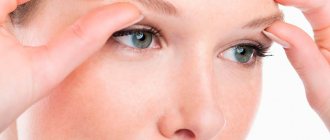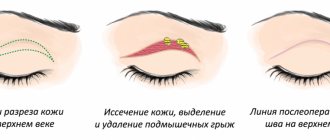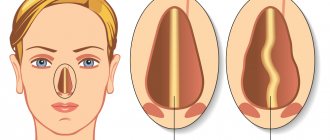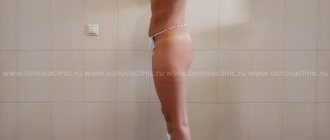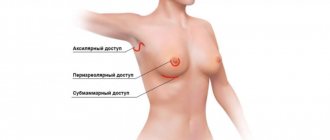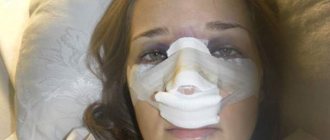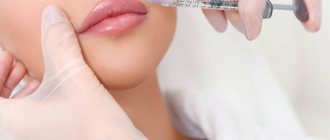Blepharoplasty - surgical plastic surgery of excess skin around the eyes and “bags” (fat hernias) - the best anti-aging plastic surgery! She gives an open, fresh and radiant look. What makes it different is a quick and easy recovery period, as well as a wow result of rejuvenation.
I talk about how long rehabilitation lasts after each type of blepharoplasty, what its features are and how you can speed up the achievement of the desired effect.
Differences in types of operations and rehabilitation period
Surgical eyelid lift is divided into the following types:
- top plastic. Effectively eliminates excess sagging skin over the upper eyelid;
- lower plastic. It fights the age-old problem of many girls - “bags” (fatty hernias) under the eyes, as well as excess skin on the lower eyelid and partially age-related wrinkles. Thanks to this technique, you can strengthen the muscles, significantly rejuvenating the face;
- transconjunctival plastic surgery. A popular method for removing bags under the eyes without making any cuts on the skin! It is often called seamless. Fatty hernias are removed through an incision in the conjunctiva (inside the eye). Suitable for young people under 40 years old with elastic skin.
- circular plastic. A one-step combination of upper and lower eyelid lifts for maximum rejuvenation effect.
Often, surgical correction of the skin around the eyes is performed under local anesthesia, which greatly facilitates rehabilitation after blepharoplasty. It is comparable to anesthesia, which is used in dentistry: a person is conscious, but does not feel pain or discomfort.
Is it possible to have a repeat eyelid lift?
Repeated blepharoplasty is performed in situations where the effect of the first operation was not particularly obtained: bags under the eyes form again, the achieved contour of the eyelids changes. Repeated surgery can be done when the result gradually decreases. This could happen in 7 years. But any surgical procedure is performed with the appearance of scars.
Such exposure to the skin should not be carried out frequently, so much depends on the condition of the skin and its ability to recover. The better and more successful the initial operation is, the longer it will be before there is a need for a repeat operation.
Probably, such a need may not arise. Blepharoplasty is usually done in combination with other cosmetic procedures. This is the approach recommended by cosmetologists.
In this case, the maximum effect can be achieved, and rehabilitation after surgery will take the same amount of time, which will allow the patient to correct age-related changes and other defects in one go. It is important to note the safety of surgery and the absence of serious contraindications.
The main thing is to choose a good clinic, which will be considered an additional guarantee of the quality of the operation and the long-term preservation of the results obtained. It is important to remember that cosmetic surgery is performed only on the basis of a license.
YouTube responded with an error: The request cannot be completed because you have exceeded your quota.
Rate this article:
- Related Posts
- Who needs laser resurfacing after blepharoplasty?
- When can you get a tattoo after blepharoplasty?
- What are the recommendations after blepharoplasty?
- When can you exercise after blepharoplasty?
- When are sutures removed after blepharoplasty?
- Why do you need eye exercises after blepharoplasty?
What actions are contraindicated?
Rehabilitation after blepharoplasty has some limitations. The plastic surgeon always talks about them during the initial individual consultation.
- In the first days after surgery, active physical activity - sports, swimming - is contraindicated. Sudden movements should be avoided. Let's say the head tilts from side to side.
- You should not wear makeup or try to “hide” signs of surgery. The skin around the eyes is injured and weakened, so there is still a possibility of infection.
- It is not recommended to get behind the wheel of a car immediately, as tearing and blurred vision may be present.
- Taboo – drinking alcohol after surgery or in the early postoperative period. It can contribute to increased swelling. Smoking is not advisable - it can lead to a longer rehabilitation period.
- It is strictly forbidden to remove crusts from the seams yourself.
- Avoid taking too hot a bath or shower. It is worth protecting yourself from temperature changes. Therefore, refuse saunas and baths.
- Avoid too much sun. Sunbathing is not recommended.
- Wearing contact lenses is not recommended.
How to speed up healing?
First of all, strictly follow all the instructions and recommendations of your surgeon. Following medical instructions is the main task of the patient, who strives to recover as quickly as possible. It is necessary to follow the prescribed dosages of medications and ointments and the regimen for caring for the injured area. Some drugs or their components can cause an allergic reaction, so you should not prescribe medications yourself. Only a surgeon can tell you what to coat the sutures after blepharoplasty.
It is also necessary to follow the prohibitions established by the surgeon. This is, first of all, protection from bending over and any actions that cause a rush of blood to the head, protection from ultraviolet rays, exclusion of sports and physical activity, visits to the bathhouse, sauna and swimming pool. Following the rules and prohibitions will help the tissues heal faster and make rehabilitation easier.
Feelings after eyelid surgery
Eyelid surgery is called the most gentle operation. This is partly due to the fact that it is performed on an outpatient basis under local anesthesia. The body is not affected by general anesthesia. Therefore, plastic surgery is easily tolerated. How might the patient feel?
- Dizziness. Mild dizziness goes away within a few hours after surgery.
- Increased tearing or dry eyes. These sensations are quite normal for the rehabilitation period. They go away in 1-3 days.
- Sensitivity to light. After surgery, there is a chance that daylight may cause discomfort.
- Impaired sensitivity. After surgery, the patient may feel numbness and “heaviness” of the eyelids. After a few months, sensitivity is completely restored.
Changing the position of the intraocular lens
This condition may occur due to design deficiencies, fixation techniques, surgery, or complications.
IOL misalignment negatively affects visual function. If significant disturbances are detected and symptoms of irritation of the uveal tissue develop, then the lens is repositioned. If it is impossible to stabilize the position of the IOL, it is removed or replaced with another type of fixation under favorable conditions. Complications in the late postoperative period are associated with the initial severe condition of the eyes, combined pathology and extensive surgical procedures, which can lead to progression of the disease or cause visual impairment.
Late complications that negatively affect visual function:
- Decompensation of the corneal endothelium with the development of endothelial-epithelial dystrophy.
- Repeated inflammation.
- Progression of glaucoma with normal intraocular pressure.
- Progression of retinal disorders.
- Changes in the transparency of the posterior capsule of the lens.
The transparency of the cornea is due to the dehydration function of its posterior layer. With a decrease in endothelial cell density, edema and endothelial-epithelial degeneration develop. Factors that increase the risk of corneal complications after surgery are identified: complicated course of the operation, changes in the correct arrangement of elements in the anterior segment of the eye, inflammation, increased ophthalmotonus.
One of the reasons for decreased vision after surgery is a violation of the transparency of the preserved posterior capsule of the lens. The formation of secondary opacities is caused by the regeneration of epithelial cells of the lens. Cell proliferation and fibrin formation begins in the equator region, then the process spreads to other zones, including the optical one, which leads to a decrease in visual acuity.
In this case, vision can be restored by excision and dissection of the posterior capsule. Typically, YAG laser capsulotomy is chosen. Modern capsulotomy techniques are characterized by minimal trauma and a reduced risk of complications. Capsulotomy is best performed six months after the operation, this reduces the likelihood of macular edema, iridocyclitis and cataract recurrence.
Based on numerous studies, the need for clinical monitoring of patients with pseudophakia after cataract extraction of various etiologies has been identified. This makes it possible to timely register the development of complications, the progression of pathology, and carry out preventive and therapeutic measures, which makes it possible to maintain eye functionality in most patients for the entire observation period.
After surgery, the patient cannot perform work for 30 days. The rehabilitation period depends on the quality of the surgical procedure, concomitant diseases and the nature of the work.
Timing and features of rehabilitation after eyelid blepharoplasty
The full recovery period takes one month. By this time, all traces of the operation have disappeared, and the stitches become invisible, taking on the color of the skin.
Rehabilitation is different for each patient. It depends on the extent of the surgical intervention, the patient’s lifestyle, his age, and the body’s ability to heal itself. Based on experience, patients recover faster after removal of skin over the upper eyelids, while the recovery period after blepharoplasty of the lower eyelids is longer. Patients feel easy and comfortable after transconjunctival (seamless) eyelid surgery. In this case, the recovery period is 3 days. For example, a patient had surgery on Friday and can go back to work on Monday.
Main problems and methods of dealing with them
- toxicoallergic conjunctivitis (most often due to drops that were used after surgery, and confirmation of this is itching, redness of the skin and whites of the eyes);
- infection.
Bruises
subcutaneous - simple, self-resolving. Sometimes puncture or removal of blood accumulation through incisions is required
It is important not to delay with the latter if there are indications, since in the future seals of the eyelids and subcutaneous nodes may appear; tense - observed if a large vessel is injured (it does not thrombose naturally), blood constantly comes out of it, squeezing the tissue around it. The condition is complemented by a feeling of fullness, numbness of the injured area
The problem is solved using a scalpel, in which the vessel is sutured; retrobulbar - is a hemorrhage in the orbit. This is a serious complication after blepharoplasty and can cause decreased vision due to compression of the microscopic vessels that supply oxygen to the retina and optic nerve. In severe situations, the following are likely: blindness, acute glaucoma. The condition is observed on the first day or on days 5-7, accompanied by pain and protrusion of the eyeball. To prevent consequences, doctors use instruments that seal the vessels. Symptoms are treated with medications to lower intraocular pressure, and if vision decreases, repeat surgery is required.
Eversion of the lower eyelid
Functional problems
- Keraconjunctivitis is an inflammation of the conjunctiva and cornea, which is considered a personal reaction to the procedure. It is treated with drugs to restore the normal state of the mucous membrane.
- Chemosis - swelling of the conjunctiva - is detected in people with excess blood vessels, less often due to infection, allergies to instilled drugs. To correct the situation, corticosteroid-based products are used.
- Tearfulness – occurs when the tear ducts are pinched. This complication goes away on its own, but in severe situations, repeated surgery may be necessary. There may also be a feeling of dryness and burning, which sometimes have to be removed by canthopexy. People who previously suffered from a lack of tear production are at risk.
Rehabilitation after blepharoplasty by day
The approximate stages of recovery by day are as follows.
Day 1. The day when the operation is performed. Eyelid surgery is performed on an outpatient basis - without hospitalization in a hospital. The patient can go home within 1 hour after surgery.
During this period, it is important to protect your eyes from active sunlight and daylight. The patient is advised to wear sunglasses before going outside.
Increased tearing or, conversely, dry eyes may be present. Swelling and blurred vision persist. By the evening of the first day, swelling will increase: the eyelids will become “heavy”, “swollen”.
Of course, you need to avoid eye strain. It is better to lie down with pillows under your head and back so that your head is higher than your body - this will minimize swelling. It is important to follow all the recommendations of the plastic surgeon and take prescribed medications.
Day 2-3. After surgical eyelid surgery, the patient may experience the following symptoms: severe swelling, slight bruising, dry eyes. The third day is the peak of maximum swelling of the eyelids. This is completely natural and corresponds to the scope of the surgery undergone. The person does not experience pain. If you feel discomfort, you can apply a cold compress to your eyes.
During this period of time, I recommend taking care of yourself and reducing eye strain. It is worth giving up working on a laptop, not watching TV, not reading.
Day 4-5. The severity of postoperative symptoms decreases, but at the same time, numbness in the operated area remains. The sutures are pronounced and swollen.
Day 5-7. During a routine check-up after surgery, the sutures are removed. The skin in this area recovers quickly, so there is no need to apply absorbable sutures. After the stitches are removed, the patient can return to work. It depends on his type of activity. There may still be redness and slight swelling in the suture area. Usually patients are not ashamed of this.
After 2 weeks, visible traces of the operation disappear - the borders of the sutures become less noticeable, redness and possible swelling disappear.
In 3-4 weeks. Scars become invisible and take on skin color after 1 month. They look like a thin stripe, which is completely invisible with open eyes.
In 1 month. You can finally evaluate the result of eyelid surgery during a routine examination with a plastic surgeon.
Gymnastics for the eyes
Exercise is an important part of rehabilitation. Gymnastics restores blood circulation to the eyelids and area around the eyes
Minor physical activity helps remove excess fluid, eliminates swelling, and accelerates the resorption of bruises.
Gymnastics tone the muscles of the periorbital region, the functions of the optic nerves are restored faster:
Warm up. Wash your hands, clean your eyelids. Gently massage your eyelids. Warming up increases circulation and response of the optic nerve. It prepares the eyelids for more challenging training, leaving them soft and supple. Basic muscle stimulation. Direct stimulation alone reduces ptosis, either through focused eye movement or through the use of a stimulating device such as an electric toothbrush. Mechanical pressure causes a reaction in the small muscles of the eyelid. Resistance training. Place your finger under your eyelids and try to close them. This creates resistance similar to lifting weights. Then place your finger over the eyelids, without pressing, slowly open your eyes without removing your fingers. The Trataka yogic eye exercise is famous among the Ayurvedic community. Since eye movement is related to eyelid movement, this exercise can be helpful. Fix your eyes on a certain object and look at it without looking away for as long as possible
The eye muscles are working at this time, it is important to feel them
Perform the exercises several times daily. The result will appear in 2 weeks. Swelling and hematomas will disappear with lightning speed, and scars will also smooth out.
How to care for your eyes after blepharoplasty?
Eye care after eyelid surgery can be divided into several stages.
- Caring for seams. In upper eyelid blepharoplasty, the suture is placed in the natural crease of the upper eyelid. In case of lower eyelid plastic surgery – one millimeter below the row of eyelashes. There is no need to treat the seams or apply ointment with it.
- Eye care. The first time after surgery, the eyes will be inflamed. Make sure that no dust or water gets into them. And also do not touch your eyes with your hands.
A plastic surgeon may prescribe eye drops. Before using them, be sure to wash your hands with soap to avoid infection.
A cooling compress can be applied to relieve swelling.
Rehabilitation after blepharoplasty of the upper and lower eyelids
Rehabilitation after upper and lower blepharoplasty is as comfortable as possible - the patient does not drop out of social life. You can walk outside, go to the store. However, it is important to protect your eyes from sunlight with sunglasses.
Transconjunctival blepharoplasty
Circular blepharoplasty + lipofilling
Transconjunctival blepharoplasty + lipofilling
Upper blepharoplasty
Transconjunctival blepharoplasty
Upper blepharoplasty
Tips to speed up recovery after blepharoplasty
Blepharoplasty involves accelerated rehabilitation if the patient adheres to the plastic surgeon’s recommendations, which also reduce the risk of possible complications.
- Physiotherapy – microcurrent therapy. I recommend the microcurrent procedure, which has a beneficial effect on the rehabilitation process after blepharoplasty. It promotes wound healing, eliminates swelling, minimizes inflammation, and normalizes lymph flow. For patients of the Vidnova clinic, 5 microcurrent procedures are included in the cost of the operation.
- Skin care. You can use baby cream to moisturize the periorbital area. It is recommended to apply cosmetics after the stitches are removed.
- Gymnastics. Simple exercises - frequent blinking, squeezing your eyes shut - promote recovery.
Look at the world with beautiful eyes! To make an appointment, just contact the administrator by phone: + 38 (067) 634-81-20 , or leave an online request for a call back.
Preparing for surgery
When preparing for circumferential blepharoplasty, pay close attention to all the recommendations of the plastic surgeon. So:
- Start undergoing examinations and tests no earlier than 2 weeks before the scheduled date of the operation.
- It is recommended to stop drinking alcohol 2-3 weeks before surgery, as well as avoid smoking tobacco.
- 2 weeks before surgery you should stop taking medications that affect blood clotting.
- 1 day before the operation, wash your hair and take a bath, since after the operation this will only be possible in a couple of days.
- 8 hours before surgery it is important to follow a “starvation diet”
- Avoid drinking liquids 5 hours before.

